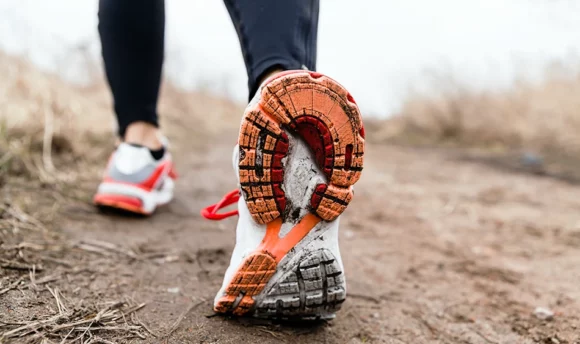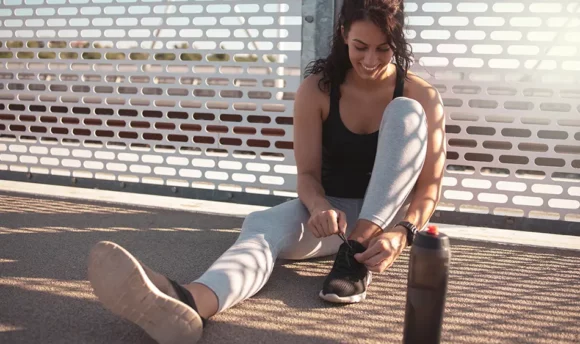Running 6 Miles a Day: Benefits and Tips How to Prepare
Running is increasing in popularity every day, and with it, audacious running goals. If you want to get in the habit of running 6 miles a day, this article can give you all the information you need to get started.

Maybe you are just beginning to run or are already an experienced runner just looking to increase the length of your running sessions.
Either way, running 6 miles a day is a distance that is both impressive to accomplish and also sure to give anyone brave enough to take on this audacious goal a whole host of benefits.
In this article, we will be providing tips on how to get yourself ready pre-run, the best way to increase strength and stamina, and information on why you should also start running 6 miles a day.
Why Is It Worth It to Start Running 6 Miles per Day?
Running 6 miles a day is a sure way to improve your muscle strength and cardiovascular fitness. Not to mention that the dedication required to make running every day a habit is a challenging goal that is sure to feel quite enjoyable to reach.
Is Running 6 Miles a Day Enough for Weight Loss?
You can expect to burn around between 400–800 calories when you run 6 miles, depending on how fast you run, as well as your age and weight.
Running this distance once won’t be enough for you to start to lose weight. However, if you get into the habit of regularly running 6 miles, you can expect to start losing fat, especially around the belly, and notice your muscle mass increase as well.
How Long Does It Take to Run 6 Miles?
How long it takes you to run 6 miles will depend on your level of running ability. On average, relatively in-shape runners can complete a 6-mile run anywhere between 50–60 minutes.
A beginner runner will generally set a slower pace and can take up to 75 minutes.
Elite runners can finish a run of this length in around 30 minutes.
7 Benefits of Running 6 Miles a Day
There are obvious benefits to running, especially when it comes to improving physique. But did you know that running can also improve mental health and even help you sleep better?
In this section, we will be covering 7 ways running can benefit both your body and your mind.
#1 Improved cardiovascular health
One of the biggest benefits of endurance sports, especially running, is the effect that it has on your cardiovascular system.
Your cardiovascular health refers to the health of your heart and blood vessels. Diseases related to this system include things like heart attacks and strokes and can be affected by lifestyle choices such as smoking, a poor diet, and lack of exercise.
In the U.S., cardiovascular disease is responsible for 1 in 4 deaths every year. This means that finding ways to improve your cardiovascular health is more important than ever.
Running is one of the best exercises to improve cardiovascular health, with regular running decreasing the risk of cardiovascular disease by anywhere from 35–55%.
This decreased risk of cardiovascular disease from running stems from the fact that running helps prevent blood clots from forming in the arteries, which – when they become dislodged – are responsible for heart attacks.
Healthy blood flow also helps reduce cholesterol, lower blood flow, and generally helps you feel more vital.
#2 Weight loss
When it comes to losing weight, running is one of the best exercises to help you shed excess pounds.
It is even better than cycling for weight loss, and even when done at a medium pace for only 30 minutes can help you burn up to 336 calories.
An important thing to remember is that muscle weighs more than fat. If your goal is to tone your body, taking progress photos can help you notice the difference in your body composition, helping you not be afraid to gain muscle, even if it means a higher number on the scale.
It’s easier to notice changes in your body when you compare your before and after photos than it is just focusing on a number on the scale.
#3 Strengthens bones and joints
This benefit might be surprising due to the fact that running is a high-impact activity. But being high-impact is the exact reason why it is so good at strengthening the bones and joints.
The stress you put on your bones as you run causes them to respond by increasing in density and strength in order to handle the burden.
As you run, the muscles in your legs contract, and this increased pressure pushes blood and other minerals, like calcium, into the bone.
Running can help improve the stability of your joints as well. As you run, you increase the strength of the muscles in your legs, including those surrounding your joints, particularly your knees.
This strengthening of your muscles can help keep your joints safe – as long as you are careful to minimize muscle imbalances by also working in some strength training.
#4 Relieves stress
Along with providing exceptional benefits for the body, running 6 miles a day can also help reduce feelings of stress and anxiety, having positive effects on mental health as well.
This is partly due to the endorphins that are released when you run. They are responsible for producing what is called a “runner’s high,” a feeling that is attributed to the increase of endocannabinoids in the bloodstream.
Endocannabinoids are actually the active ingredient in cannabis and, when naturally produced by the body, can leave us feeling calm and anxiety-free.
#5 Better sleep
Getting better sleep is something we can all benefit from. This perk is directly related to the hormones that are released when you run.
Along with several other endorphins, running boosts the production of serotonin, which is a feel-good hormone that can help us feel more relaxed and at peace.
It is also the hormone that is a precursor for the release of melatonin, the chemical responsible for sleep. Increased amounts of serotonin in the body can boost the production of this very important hormone, helping you fall asleep faster.
Running also aids in getting you better sleep since it is a high-output exercise that can burn off unnecessary stress, which can often show up as feelings of stress and anxiety in the body.
When you do exercise to help relieve anxiety, which is both cortisol and adrenaline-boosting, the chances of you lying awake and ruminating on anxious thoughts are a lot less likely.
#6 Improves immunity
Running provides benefits to the functioning of your immune system in a number of ways.
Firstly, it increases the amount of immune-supporting cells in your body, which help both detect and resist any pathogens that enter your body.
It also helps reduce stress hormones in the body – like cortisol – which can wreak havoc on your immune system if levels get too high.
This is due to the role that cortisol plays when it comes to lymphocytes – aka white blood cells – in your body. Cortisol plays a part in downregulating the production of these immune-boosting cells.
This can lead to chronic inflammation, which is now being linked to coronary disease and even Alzheimer’s.
#7 Improves longevity
Due to all of the combined factors that were previously mentioned, you can easily conclude that running 6 miles a day has amazing effects on overall longevity.
There are numerous studies that point to the fact that running can lower mortality rates by 23–30% and that runners can be expected to live up to 3 years longer than those who don’t partake in regular exercise.
The best part of these studies is that their evidence suggests that even running 1 time per week can help people see benefits. This means that getting into the habit of going for long runs on a daily basis is a sure way to keep you healthy and well for longer than ever.
How to Prepare for a 6-Mile Run
Running 6 miles a day, especially in the beginning, is bound to be a challenge. In order to be successful with your new goal, you will want to do everything you can to prepare yourself beforehand.
The following 5 tips will help you get ready for your big run.
Get a heart rate monitor
When running long distances, it’s important to make sure you are exercising within the aerobic zone of your heart rate.
This is because exercising more vigorously will cause you to shift into anaerobic exercise, which isn’t sustainable for more than a few minutes.
By figuring out your maximum heart rate – which can be approximated by subtracting your age from the number 220 – and running at a slow pace that keeps you between 60–75% of this maximum, you will ensure you are running at an efficient pace.
It might not seem important, but this is a tip that can help make running longer and farther a lot more accessible.
Pick comfortable running shoes
Wearing the right pair of running shoes might not seem overly important. But surprisingly enough, shoes that are too heavy don’t have enough support or don’t offer enough height through the heel can actually slow you down for a number of reasons.
The first is that shoes that are too heavy can make you feel like you are running with weights on your feet and can cause inefficient energy output.
Another is that shoes that lack proper support can cause unnecessary impact when your feet hit the ground. This can contribute to things like shin splints and, in more serious cases, even lead to stress fractures.
Lastly, sneakers that are too flat and lack extra height through the heel can cause tightness in the lower legs.
If you are someone who feels pain in their calves while they run, investing in other sneakers with a higher heel could be just the change you need. Running flat-footed can oftentimes put unnecessary strain on the calf muscles, causing them to fatigue more quickly than they should.
Increase gradually
Aspiring to run 6 miles a day is a great goal, but moving slow – especially for beginners and those of you who are injury-prone – is a must.
Not doing so can result in overuse injuries that can take weeks, if not months, to heal. Having a setback like this can keep you from reaching your goals and force you to start again from square one.
Although setting audacious goals is commendable, instead focus on making incremental increases in the length or intensity of your runs. If you run the same distance of 1 mile every week, then a great goal would be to increase the mileage of your daily run to 1.1 miles next week.
Moving at this pace might not be glamorous and is sure to take longer. But it will also give your body time to adapt, increasing the strength of your muscles, bones, and joints and reducing the chances of injuring yourself.
Always make sure to pencil in enough rest days between your runs for your body to fully recover.
Balance your diet before starting
Get enough carbohydrates
Carbohydrates are an important part of having enough energy to run. When you eat carbs, they are stored in the body of glycogen. Glycogen is a key component in the creation of ATP, which is what your muscles use as fuel when you exercise.
Not getting enough carbs can cause you to fatigue quickly while you run and can decrease your running performance.
When you’re running long distances, eating healthy carbohydrates – like quinoa, oats, whole-grain pasta, and even bananas – will give you the energy you need to last the distance.
What to eat pre-run
What you choose to eat pre-run will depend on the time of day you run. Running in the morning definitely has its benefits, but some people prefer to do their exercise in the evenings after work.
If you decide to run in the morning, it’s a good idea to have a light breakfast. Something like oatmeal with berries and Greek yogurt is perfect. Although fasted running has a lot of hype, it’s not the best idea for longer runs such as those lasting 6 miles.
When running in the evening, you should stop eating at least an hour before you plan to run to prevent cramping and digestive issues.
Try a running app
Whether you are just starting out or feel as though you’ve hit a plateau, investing in a running program can help fast-track your progress.
Running programs are often designed with a number of different running styles. Switching up the kind of run you do is a great way to keep your workouts more interesting, and cross-training can assist in building up strength and endurance more quickly.
An app that we recommend for both beginners as well as more experienced runners is Joggo. They create running plans that are personalized to match any level of fitness and also have meal plans, perfect for anyone who needs help improving their diet.
Using a running app can be the extra bit of accountability that you need in order to stay consistent with your goal of running 6 miles a day.
FAQs
The specific number of calories you burn when running 6 miles will depend on your age, sex, and current weight.
Most runners can expect to burn around 100 calories per mile. This would leave your total number of calories burned after running 6 miles somewhere around 600.
For beginners, completing a 6-mile run in under an hour is a good goal.
An experienced runner should aim to finish in between 30–40 minutes, for an average mile time of between 5 and 6.5 minutes.
A Word From Our Coach
Running 6 miles a day is an audacious goal and one that is sure to leave you in the best shape of your life. However, this will only happen if you choose to take on this goal with the intention of becoming stronger and healthier.
Choosing to try to run 6 miles a day just for the sake of cracking out impressive weekly mileage or losing weight fast can cause you to make sacrifices that will leave your body even weaker than it was before.
Instead, work out as hard as you can, but also make sure to give yourself a rest day when your body is asking for it.
Make sure to make the most of these rest days by actually resting and fuelling your body with foods that will give you energy and support muscle growth.
Take things slowly, and before you know it, you’ll be in the best shape of your life and ready to take on races like a half-marathon. Not to mention that your race pace will be something to boast about.
Bottom Line
Running 6 miles a day has many amazing benefits for both the body and the mind, including increased muscle and bone strength, weight loss, improved cardiovascular health, a reduction of stress and anxiety, and more.
Although it is an audacious undertaking, it is accessible to anyone and everyone, as long as they are willing to put in some hard work in order to get their body ready.
With enough time, dedication, and maybe the help of a personalized running program, you too can be successful at running 6 miles a day and will be guaranteed to change your life along the way.

















































 Select your language:
Select your language: 








